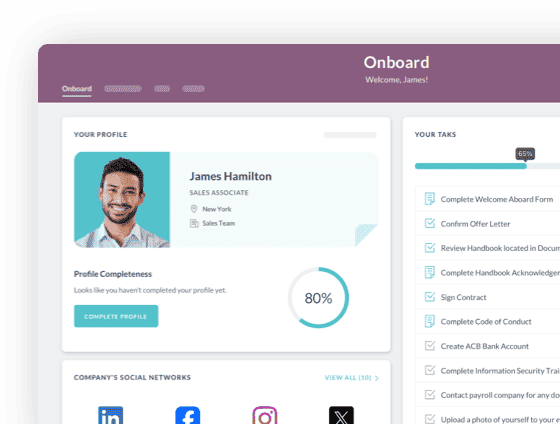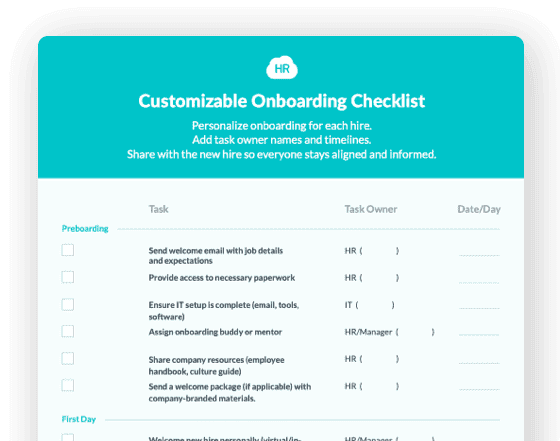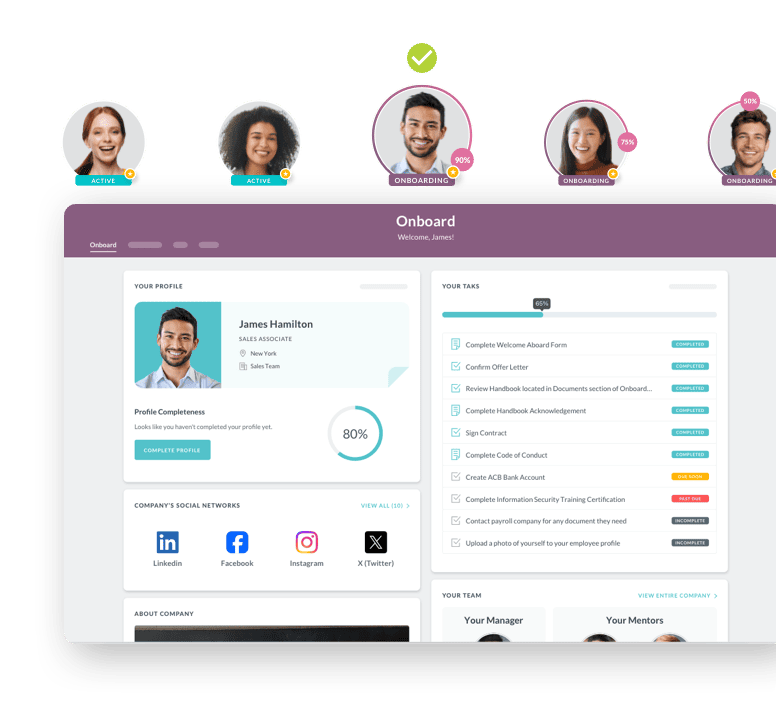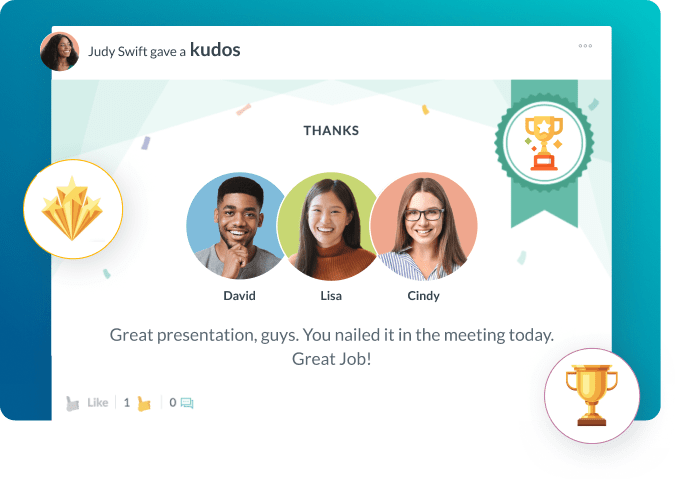Employee Onboarding

 Cut onboarding time
by 60%—here's the
Ultimate Checklist
that helped do it.
Cut onboarding time
by 60%—here's the
Ultimate Checklist
that helped do it.

What is Employee Onboarding?
Employee onboarding is the strategic process of integrating a new employee into an organization and its culture. It goes beyond the initial paperwork and orientation, aiming to equip new hires with the necessary tools, knowledge, and social connections to become productive and engaged members of the team. A well-structured onboarding process can significantly impact employee retention, satisfaction, and long-term success within the company. It's a critical component of the overall employee lifecycle, setting the stage for a positive and lasting relationship between the employee and the organization. The goal is to make the new hire feel welcome and supported from day one, helping them to quickly understand their role, the company's mission, and their place within it.
Key Components of an Effective Onboarding Program
A successful onboarding process typically includes several key elements, all working together to ensure a smooth transition for the new hire. These components can be broken down into four main categories:
Pre-boarding:
This phase begins the moment an offer is accepted and before the employee’s first day. It involves completing essential paperwork, providing a welcome packet, and sending communications that build excitement and anticipation. This can include a welcome email from the manager or a link to the company's HRIS system to complete forms digitally, making the first day less about paperwork and more about people.
Orientation:
This is the traditional first-day experience. It includes an introduction to the company's mission, vision, values, and policies. It's also when new hires meet key team members and learn about the organizational structure. This part of the process is often managed through a centralized onboarding portal or HR software, ensuring consistency for all new hires.
Role-Specific Training:
This is where the employee learns the specifics of their job. It includes training on necessary software, tools, and processes. It's also the time for a new hire to get a clear understanding of their performance expectations and goals. A strong training program can be supported by digital learning platforms that offer on-demand courses and resources.
Ongoing Integration:
Onboarding shouldn't end after the first week. This phase can last for several months and includes regular check-ins with managers, mentorship programs, and opportunities for feedback. This continuous support helps new employees feel connected and ensures they are on the right track. This phase is crucial for employee engagement and building a sense of belonging.
The Business Value of Strategic Onboarding
Investing in a robust onboarding program offers a significant return on investment for a business. It's not just a nice-to-have; it's a strategic imperative. Here’s a summary of the key benefits:
|
Benefit |
Description |
Business Impact |
|
Increased Retention |
New employees are more likely to stay with a company that makes them feel valued and prepared. |
Reduces the high cost of turnover, including recruiting and training new hires. |
|
Improved Time-to-Productivity |
A structured onboarding process gets employees up to speed faster. |
The new hire contributes value to the company more quickly, improving team and company performance. |
|
Enhanced Employee Engagement |
Feeling connected to the company's mission and team from the start leads to higher job satisfaction. |
Engaged employees are more innovative, productive, and less likely to leave. |
|
Stronger Company Culture |
Onboarding is the first opportunity to reinforce company values and expectations. |
It helps build a cohesive and positive work environment where employees understand and embody the culture. |
|
Better Compliance |
Ensures new hires are aware of and adhere to all company policies and legal requirements. |
Mitigates legal risks and fosters a professional, compliant workplace. |
Best Practices for an Effective Onboarding Program
Creating a successful onboarding experience requires a thoughtful approach. Here are some best practices to consider:
Start Early:
The onboarding process should begin the moment the candidate accepts the job offer. This "pre-boarding" phase helps build excitement and can be used to complete administrative tasks, like filling out forms through a secure HR software platform.
Personalize the Experience:
While a standardized process is important for consistency, personalize parts of the experience for each new hire. This could mean a personalized welcome note from their manager or a specific training path tailored to their role.
Assign a Mentor or Buddy:
Pairing a new employee with a seasoned team member can provide invaluable support. This person can answer informal questions, help them navigate the company culture, and act as a social connection. A study by the Society for Human Resource Management (SHRM) found that employees who have a good onboarding experience are more likely to stay with their organization.
Use Technology:
Leverage technology to streamline the process. An all-in-one HR platform can automate paperwork, provide access to training materials, and track the new hire’s progress. This frees up managers and HR professionals to focus on the human side of onboarding.
Gather Feedback:
After a new employee has been with the company for a while, ask them for feedback on their onboarding experience. This valuable information can be used to continuously improve the process.


Common Pitfalls to Avoid in Onboarding
Even with the best intentions, companies can make mistakes that derail the onboarding process. Avoiding these common pitfalls is crucial:
Overloading with Information:
Bombarding new hires with too much information on the first day can be overwhelming and ineffective. Spread out training and information over several weeks.
Lack of Structure:
An ad-hoc or disorganized onboarding process can make new hires feel lost and undervalued. A clear, documented plan ensures a consistent and positive experience for everyone.
Ignoring the Manager's Role:
The direct manager is a new hire’s most important resource. Their active involvement and support are critical for a successful integration. Gallup research has shown that employees who have a great manager are more likely to be engaged and feel a sense of purpose at work.
Ending Onboarding Too Soon:
The first day or week is just the beginning. Effective onboarding should last for a minimum of 90 days, with continuous check-ins and support.
The Future of Employee Onboarding
The future of employee onboarding is increasingly focused on technology, personalization, and a continuous experience. As remote and hybrid work models become more common, organizations are relying on digital solutions to deliver a seamless onboarding experience, no matter where the employee is located. The rise of sophisticated HR management software will allow for even more personalized and data-driven onboarding processes. Companies will use analytics to track new hire progress and identify areas for improvement. Onboarding will evolve from a one-time event into a continuous cycle of learning, feedback, and growth, starting from the first day and extending throughout an employee's career.
Conclusion
Employee onboarding is a critical, strategic function that sets the tone for an employee's entire tenure at a company. By moving beyond traditional orientation and embracing a structured, comprehensive, and human-centric approach, businesses can significantly improve employee retention, boost productivity, and build a stronger, more engaged workforce.
Keep Reading
Night Shift, Float Pool, PRN: Onboarding Non-Traditional Nursing Schedules
Most nurse onboarding programs assume everyone works 9-to-5. Your carefully designed
Onboarding Home Health and Community Care Teams Who Never See the Main Office (The Tether Strategy)
You hire them on Monday. They see their first patient on Tuesday. And you might not see
Credential Tracking in Healthcare: How to Automate License Renewals and Stay Audit-Ready
A nurse shows up ready for her shift but her license expired yesterday. You scramble for
Ready to streamline your onboarding process?
Book a demo today and see how HR Cloud can help you create an exceptional experience for your new employees.







